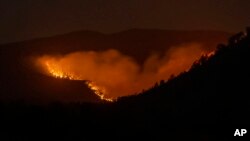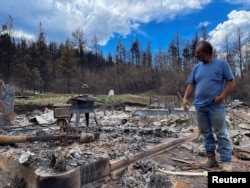Two years after the U.S. Forest Service sparked what would become the largest and most destructive wildfire in New Mexico’s recorded history, independent investigators say there are gaps that need to be addressed if the agency is to be successful at using prescribed fire as a tool to reduce risk amid climate change.
The investigation by the Government Accountability Office was requested by U.S. Rep. Teresa Leger Fernández after communities in her district were ravaged in 2022 by the Hermit's Peak-Calf Canyon Fire.
The congresswoman wanted to know what factors the Forest Service had identified as contributing to the escape of prescribed fires over the last decade and whether the agency was following through with reforms promised after a pause and review of its prescribed burn program.
The report made public Monday notes there were 43 escapes documented between 2012 and 2021 out of 50,000 prescribed fire projects. That included blazes in national forests in more than a dozen states, from the California-Nevada border to Utah, New Mexico, Idaho, North Carolina and Arkansas.
With the U.S. Forest Service and other land management agencies tapping into federal infrastructure and inflation reduction funding to boost the number of prescribed burn operations over the next 10 years, Leger Fernández said it's more important than ever to ensure they are doing it safely.
The congresswoman was visiting northern New Mexico over recent days, appreciating how things have greened up with summer rains. But the forests are still tinder boxes, she said.
“We need to address our forest, but we need to do it in a responsible way," she told The Associated Press. "When you play with fire, there is no margin for error.”
The Forest Service ignites about 4,500 prescribed fires each year, reducing fuels on about 1.3 million acres. It's part of a multi-billion dollar cleanup of forests choked with dead trees and undergrowth.
There have been mixed results as federal land managers have fallen behind on some projects and skipped over some highly at-risk communities to work in less threatened ones, according to a 2023 AP review of data, public records and congressional testimony.
However, the Forest Service said in a response to the GAO that it is making progress and generally agrees with the findings made public Monday. Forest Service Chief Randy Moore wrote that his agency will create and implement a corrective action plan to address the gaps.
Moore also noted 2023 marked a record year for treatments of hazardous fuels on forest lands and his agency was on track to offer more training to build up crews who can specialize in prescribed burn operations.
“The agency is using every tool available to reduce wildfire risk at a pace and scale which will make a difference within our current means,” Moore wrote.
The GAO reviewed volumes of documents over several months, interviewed forest officials and made site visits over many months. The investigation found the Forest Service has taken steps toward implementing several immediate recommended changes following the Hermit's Peak-Calf Canyon Fire. That included developing a national strategy for mobilizing resources for prescribed fire projects.
There were dozens of other actions the agency identified as part of its 2022 review, but the GAO found “important gaps remain” as the Forest Service hasn't determined the extent to which it will implement the remaining actions, including how or when.
The GAO is recommending the Forest Service develop a plan for implementing the reforms, set goals, establish a way to measure progress and ensure it has enough resources dedicated to day-to-day management of the reform effort. It also pointed out that the Forest Service in agency documents recognized the reforms will require major changes to practices and culture.
Leger Fernández said she hopes change will come quickly because wildfires are becoming more expensive and more dangerous.
“They are killer fires now. They move very fast, and people cannot get out of the way fast enough,” she said. “And I think that kind of massive emergency that they are will lead to faster change than you might normally see in a large federal bureaucracy.”














